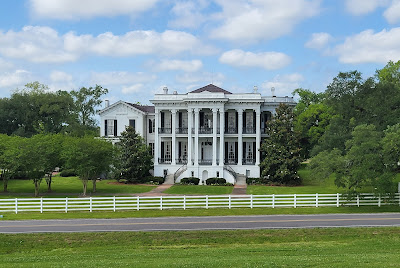Sugar cane was a massive and lucrative agricultural industry, along the southern Mississippi River. It was called "white gold", because of the large profits on the backs of slave labor. Plantation country, as it is known, is mainly along the west side of the Mississippi River running between New Orleans and Natchez, Mississippi. Many of these homes were destroyed during the Civil War, which ended that era. Some remain, restored to their former glory. About forty plantations are now open for public tours. We stopped at five of these plantations along LA18, River Road and toured two of them.
OAK ALLEY PLANTATION
Oak Alley is known for its distinguishing feature of 28 southern live oaks trees planted 800 feet apart. The trees are estimated to be between 220-250 years old.
The "Big House" was completed in 1839 by the first owner, Jacques Roman, in Greek Revival architecture.
The 1920's formal garden, referred to as the East Garden.
The second-floor balcony/porch presents a view of the vast sugar cane fields and encircles the entire house.
Pictures were prohibited inside the home.
The back side of the home is almost as beautiful as the front.
On the back side of the home an oak lined path led to the slave quarters and blacksmith shop.
Old kettles used for boiling sugar cane now provide ornamental landscaping features.
This plantation once housed over 200 slaves. Some of the slave quarters have been restored and contain artifacts detailing the lives of sugar plantation slaves. House, field, and craftsmen slaves resided in separate cabins. One of Oak Alley's slaves actually developed the technique of grafting pecan trees that resulted in today's paper shell pecans.
ST. JOSEPH PLANTATION
We passed by the St. Joseph Plantation along the River Road. Took a picture, but not a tour.
This is a Creole Plantation, meaning household speaks French, of Catholic religion, and are native born Louisianans.
LAURA PLANTATION
This raised brick basement Creole plantation house was built in 1805. Originally named the Duparc Sugar Plantation, the name of the first residents.
The Parlor
An electrical fire in 2004 singed much of the back of the house as well as destroying the entire kitchen wing. Much work went into restoring this beautiful home.
Here is what remains of the kitchen wing burned in 2004.
Formal Gardens
Restored Slave Quarters
EVERGREEN PLANTATION
This plantation tour is temporarily closed.
Evergreen Plantation is the most complete plantation complex in the south. Twenty-two slave cabins, gardens, and many outbuildings remain on the property.




























































